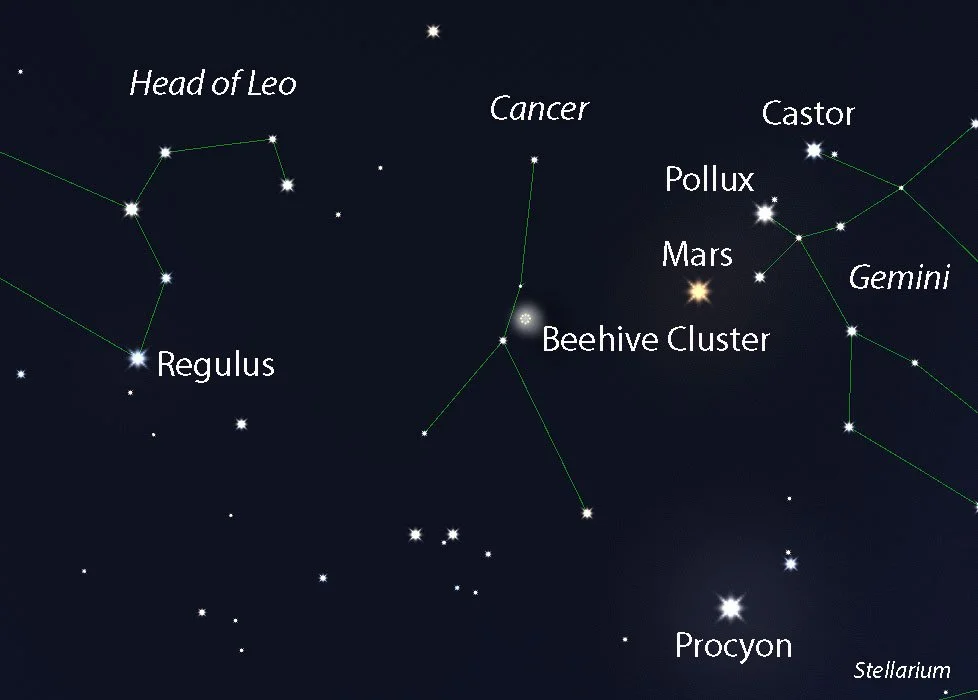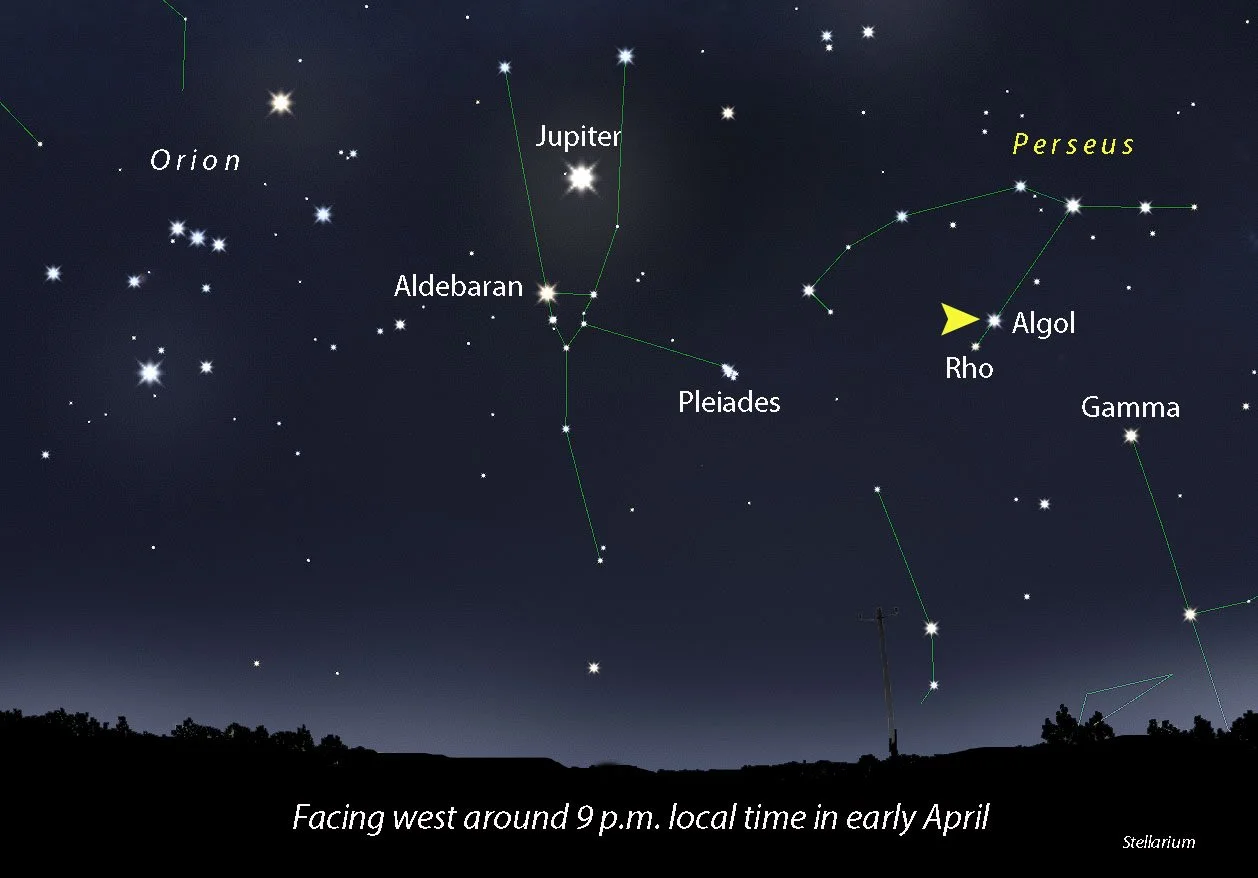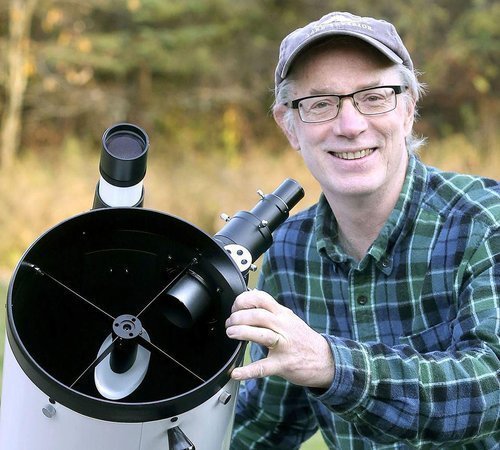April 2025 Night Sky Calendar
By Bob King
We'll soon bid adieu to Orion and friends, the sparkly winter constellations that have enlivened the night sky since last December. They still hold sway in the west and southwest during the first half of April, but by month’s end, they brush up against dusk and set early.
Venus, Mercury and Saturn have recently moved into the morning sky, leaving Jupiter and Mars as the sole bright evening planets. Jupiter maintains its brilliance, but Mars continues to fade as its distance from Earth increases. Both planets are on the move to the east as they orbit the sun. You can see this eastward (to the left) motion by noting their locations in relation to nearby stars at different times during the month.
Reddish-orange Aldebaran, located below Jupiter, serves as a good marker for the giant planet’s travels. For Mars, you can use Castor and Pollux in Gemini. The Red Planet will cross the border from Gemini into the neighboring constellation Cancer the Crab on April 12. If you check their positions every two weeks, you’ll spot them on the run.
Venus remains rather low at dawn but slowly gains altitude as the month rolls along. Look for it in the east 45-60 minutes before sunrise. Venus will point to Saturn, which returns to view the third week of April. The waning crescent moon gets into the act on April 24 and 25, when it joins them both in pretty trios.
Our featured constellation is Cancer the crab, a faint, sparse group of stars tucked between the bright “backwards question mark” that outlines Leo’s head and the bright stars Castor and Pollux in Gemini. You’ll need a dark sky with as little moon as possible to make out Cancer, which is shaped like an upside-down letter Y. Cancer has one of the finest binocular star clusters in the sky, named the Beehive. It’s smack dab in the middle of the constellation not far from Mars. Take a look.
Like Leo last month, the crab features in the story of the 12 Labors of the Greek hero and demigod Heracles (Roman “Hercules”). While Heracles was fighting the multi-headed sea snake Hydra, Cancer nipped at his feet with its claws. The hero promptly crushed the crab then put an end to Hydra. Both creatures, along with Heracles (Hercules), were placed in the sky as constellations.
Download the free Stellarium Mobile app for Android and iPhone to help you find and identify the current planets and constellations. Do a Google search, then install the app, set it in night mode (red screen) and point your phone skyward. For a free April sky map and calendar go to www.skymaps.com/downloads.html
April 2025 night sky happenings:
Events (a.m. indicates the event happens in the morning sky):
April 1 – 4-day-old crescent moon shines just above the Pleiades star cluster tonight. Together they’ll make a beautiful sight in a pair of binoculars.
April 3 – The star Algol in the constellation Perseus is a close binary star. Every 2.9 days the larger, fainter companion eclipses the brighter star, and Algol fades. It’s normally magnitude 2.1, equal to a Big Dipper star. But it dims to 3.4 during an eclipse. At 9:11 p.m. CDT tonight, Algol will be in mid-eclipse. Look around 9 p.m., compare it to Gamma Andromedae and Rho Persei (on the map), then return around 11:30 p.m., and you’ll see the star recover. If you can’t stay up that late, wait till the next clear night and do your comparison. For more details, see skyandtelescope.org/observing/the-minima-of-algol/
April 4 – Waxing moon appears to the right and above the bright planet Jupiter in the western sky.
April 11 – Mars forms a straight line with Gemini’s brightest stars Pollux (closer to Mars) and Castor tonight. Since the planet is moving east, it will only take a night or two for you to see it break the line.
April 12 – Full Pink Moon. Rises around local sunset and sets the next morning around sunrise. Named for moss pink, an eastern U.S. wildflower. Look closely just one moon-diameter above (north) of the moon early this evening, and you’ll spot Virgo’s brightest star Spica. The two will be in close conjunction.
April 15-30 (a.m.) – The International Space Station makes west-to-east passes across the dawn sky. For a complete list of pass times for your location, log in to Heavens-Above.com, select your location and then click the blue ISS link. Or just download NASA’s Spot the Station app at the app store or Google Play.
April 16 (a.m.) – Waning gibbous moon covers (occults) the 3rd magnitude star Fang in Scorpius early this morning. You will need a small telescope to watch the bright moon slowly move toward and then swiftly blank the star from view. It will return to view minutes to more than hour later (depending on your location) along the moon’s opposite side. For details and times for many cities, go to http://www.lunar-occultations.com/iota/bstar/0416zc2287.htm Remember to change the time from Universal Time (UT) to your local time. Subtract 4 hours for Eastern, 5 for Central, 6 for Mountain and 7 for Pacific.
April 20 (a.m.) – Last quarter moon. Rises around 1 a.m. daylight time and stands due south around sunrise.
April 22 (a.m.) – Peak of the annual Lyrid meteor shower. Up to 15 meteors will be visible streaming from near the bright star Vega from around midnight until 4 a.m. local time.
April 25 (a.m.) – Thin morning crescent joins Venus and Saturn in a tight group low in the southeastern sky at dawn. Use binoculars and look about an hour before sunrise from a location with an unobstructed view to the east. A small telescope will show Saturn’s rings as a razor-thin line. Our view of them is currently almost “edge-on.”
April 27 – New Moon. The moon lies in the same direction as the sun and is invisible in the daytime sky.
Bob King is an amateur astronomer, author, and passionate educator. He served as a photographer and photo editor at the Duluth News Tribune for 39 years and taught at the UMD planetarium. Bob’s work had a great impact on Voyageurs National Park. To achieve International Dark Sky Park certification, the park was required to host dark sky education events. Through the Night Sky Explorer webinars, the Conservancy was able to fulfill this component and help secure the certification for Voyageurs National Park. We can’t thank Bob King enough for sharing his talents and knowledge with the Conservancy community to support dark sky preservation.








